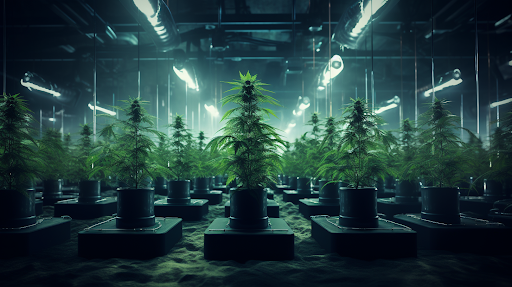Uncategorized
Future Cannabis Cultivation Techniques to Watch Out For
The cannabis industry has undergone a profound transformation in recent years, with shifting attitudes and increasing legalization across the globe. As more countries embrace the medicinal and recreational use of cannabis, the cannabis cultivation industry is rapidly evolving. Cannabis cultivation techniques are at the forefront of this transformation, as researchers and growers alike seek innovative methods to enhance plant quality, yield, and sustainability. This article delves into the future of cannabis cultivation techniques, exploring emerging methods and the potential impact of these changes on the industry.
The Cannabis Plant and Its Cultivation
Cannabis, a versatile and hardy plant species, has been cultivated for centuries for its various uses, from industrial hemp to recreational and medicinal purposes. The two main subspecies of the cannabis plant, Cannabis sativa, and Cannabis indica, along with their hybrid variants, offer unique attributes and qualities that can be optimized through cultivation techniques.
Here’s a brief overview of the process of cannabis cultivation:
Genetics and Strain Selection:
- Choose a cannabis strain that suits your goals (e.g., THC content, CBD content, flavor, growth characteristics).
Germination:
- Start with high-quality cannabis seeds.
- Germinate the seeds by placing them in a moist, dark environment until they sprout.
Seedling Stage:
- Transplant the germinated seeds into small pots with a suitable growing medium.
- Provide adequate light, humidity, and ventilation.
Vegetative Growth:
- Transplant seedlings to larger containers.
- Maintain a 16-18 hour light cycle to encourage plant growth.
- Prune and train the plants to encourage a bushy shape.
Flowering Stage:
- Adjust the light cycle to 12 hours of light and 12 hours of darkness to trigger flowering.
- Monitor and adjust environmental conditions (temperature, humidity, and ventilation).
- Continue pruning and support for the growing buds.
Harvesting:
- Harvest when the trichomes (resin glands) on the flowers change color (usually cloudy or amber).
- Cut the plants at the base and trim away excess leaves
Drying:
- Hang the harvested cannabis in a dark, cool, and dry space to dry slowly over 1-2 weeks.
- Maintain proper humidity levels to prevent mold.
Curing:
- Place dried buds in airtight containers (jars) for several weeks to months.
- Open the containers regularly to release excess moisture and improve the aroma and flavor.
Testing:
- Consider having your product tested for cannabinoid content, contaminants, and potency.
Storage:
- Store the cured cannabis in a cool, dark place to maintain its quality.
Throughout the cultivation process, it’s important to monitor for pests, diseases, and nutrient deficiencies. Additionally, ensure that your local laws and regulations are followed, as cannabis cultivation may be subject to legal restrictions in many regions.
The Future of Cannabis Cultivation
The future of cannabis cultivation lies in the development of cutting-edge techniques and methodologies that promise to revolutionize the industry. From micropropagation studies to regeneration studies, we break down the work being done with cannabis plant material to improve future cultivation techniques.
Micropropagation Studies
One of the most promising techniques for the future of cannabis cultivation is micropropagation. This method involves the growth of cannabis plants from small tissue samples in a laboratory setting. It allows for the rapid multiplication of genetically identical plants, ensuring consistency and quality. Micropropagation studies are underway to refine the process for cannabis plants, enabling mass production of uniform plants for both medicinal and recreational markets.
Stable Transformation
Stable transformation techniques involve the integration of foreign DNA into the cannabis plant’s genome. This genetic modification can be used to enhance desired traits, such as resistance to pests and diseases, increased cannabinoid production, or improved yield. Research in stable transformation is paving the way for tailored cannabis strains with specific characteristics.
Transient Transformation
In contrast to stable transformation, transient transformation is a non-permanent genetic alteration. It allows for the introduction of foreign genetic material without permanently modifying the plant’s genome. This approach is especially valuable for research purposes, as it enables the quick testing of various genetic modifications before committing to stable transformation.
Regeneration Studies
Regeneration offers growers a sustainable and cost-effective means of propagating plants. This technique involves harnessing the plant’s innate ability to regrow from cuttings or tissue samples, allowing for the preservation of desirable genetic traits and the production of new plants without the need for cannabis seeds. By reducing the reliance on traditional seed propagation, regeneration studies have the potential to enhance consistency in plant quality, optimize yield, and conserve resources, ultimately contributing to the industry’s sustainability.
Apical Dominance
Apical dominance, a key aspect of plant physiology, is poised to become an important trend in future cannabis cultivation. This phenomenon, where the main, or apical, bud suppresses the growth of lateral buds, can be manipulated to optimize plant shape, increase yield, and control overall plant structure. This technique represents a promising avenue for enhancing cannabis cultivation practices, ensuring higher-quality plant material and improved yields.
The Impacts of Cannabis Cultivation Transformations
As cannabis cultivation techniques continue to advance, their impacts on the industry are multifaceted:
- Yield and Quality Enhancement: One of the primary objectives of future cultivation techniques is to boost yield and quality simultaneously. Methods like micropropagation and stable transformation offer the potential for consistent and high-quality cannabis production on a large scale.
- Sustainability: The cannabis industry, like any other agricultural sector, faces sustainability challenges. Sustainable cultivation techniques, including organic practices and controlled environment agriculture, are gaining traction as the industry matures. These methods aim to reduce resource consumption, lower environmental impacts, and ensure long-term viability.
- Customization: The ability to genetically customize cannabis plant species is a game-changer. Customization enables growers to develop strains with unique cannabinoid and terpene profiles, allowing for the creation of cannabis products tailored to specific medicinal or recreational purposes.
- Medical Advancements: The development of stable transformation techniques has the potential to lead to significant medical breakthroughs. Cannabis strains could be engineered to produce consistent and precise ratios of cannabinoids, potentially advancing the treatment of various medical conditions.
- Economic Growth: The cannabis industry is a growing economic force, and emerging cultivation techniques are poised to further expand its contributions to job creation, tax revenue, and investment opportunities.
Buy Cannabis Online
Magic Mushroom Dispensary offers an extensive selection of premium cannabis products. Our virtual shelves are stocked with a diverse array of cannabis strains, including indica, sativa, and hybrid varieties, catering to different effects and flavor profiles. If you’re looking for something a bit stronger, we also offer magic mushrooms and DMT products. Whether you’re a recreational user looking for a unique experience or a medicinal user seeking relief, our range of high-quality products ensures you’ll find exactly what you need to enhance your journey.
Frequently Asked Questions
Distinguishing and cultivating female cannabis plants is essential. Female plants are prized for their resin-rich flowers, where cannabinoids and terpenes are concentrated. Using feminized seeds is ideal as it means you don’t have to spend time getting rid of male plants
The cannabis cultivation industry has experienced a substantial transformation with the emergence of medicinal cannabis. Growers and researchers are now focusing on developing specific medicinal plants with optimized cannabinoid and terpene profiles to address various medical conditions. This shift underscores the industry’s commitment to providing safe and effective medicinal options.
The growth of the cannabis cultivation industry has significant economic and social impacts, including job creation, tax revenue generation, and investment opportunities, as well as addressing social equity and justice issues in regions where cannabis is legalized.

